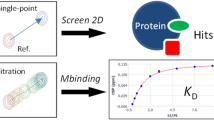Abstract
NMR ligand-affinity screens are vital to drug discovery, are routinely used to screen fragment-based libraries, and used to verify chemical leads from high-throughput assays and virtual screens. NMR ligand-affinity screens are also a highly informative first step towards identifying functional epitopes of unknown proteins, as well as elucidating the biochemical functions of protein–ligand interaction at their binding interfaces. While simple one-dimensional 1H NMR experiments are capable of indicating binding through a change in ligand line shape, they are plagued by broad, ill-defined background signals from protein 1H resonances. We present an uncomplicated method for subtraction of protein background in high-throughput ligand-based affinity screens, and show that its performance is maximized when phase-scatter correction is applied prior to subtraction.



Similar content being viewed by others
References
Baker M (2013) Fragment-based lead discovery grows up. Nat Rev Drug Discov 12:5–7. doi:10.1038/nrd3926
Dalvit C, Pevarello P, Tato M, Veronesi M, Vulpetti A, Sundstrom M (2000) Identification of compounds with binding affinity to proteins via magnetization transfer from bulk water. J Biomol NMR 18:65–68. doi:10.1023/A:1008354229396
Dunn OJ (1961) Multiple comparisons among means. J Am Stat Assoc 56:52–64. doi:10.2307/2282330
Eaton JW, Bateman D, Hauberg S (2008) GNU octave manual version 3. Network Theory Limited, Bristol
Ferentz AE, Wagner G (2000) NMR spectroscopy: a multifaceted approach to macromolecular structure. Q Rev Biophys 33:29–65. doi:10.1017/s0033583500003589
Hajduk PJ, Greer J (2007) A decade of fragment-based drug design: strategic advances and lessons learned. Nat Rev Drug Discov 6:211–219. doi:10.1038/nrd2220
Hajduk PJ, Olejniczak ET, Fesik SW (1997) One-dimensional relaxation- and diffusion-edited NMR methods for screening compounds that bind to macromolecules. J Am Chem Soc 119:12257–12261. doi:10.1021/Ja9715962
Harner MJ, Frank AO, Fesik SW (2013) Fragment-based drug discovery using NMR spectroscopy. J Biomol NMR 56:65–75. doi:10.1007/s10858-013-9740-z
Hwang TL, Shaka AJ (1995) Water suppression that works—excitation sculpting using arbitrary wave-forms and pulsed-field gradients. J Magn Reson A 112:275–279. doi:10.1006/jmra.1995.1047
Lepre CA (2011) Practical aspects of NMR-based fragment screening. Methods Enzymol 493:219–239. doi:10.1016/b978-0-12-381274-2.00009-1
Lepre CA, Moore JM, Peng JW (2004) Theory and applications of NMR-based screening in pharmaceutical research. Chem Rev 104:3641–3675. doi:10.1021/Cr030409h
Mayer M, Meyer B (2001) Group epitope mapping by saturation transfer difference NMR to identify segments of a ligand in direct contact with a protein receptor. J Am Chem Soc 123:6108–6117. doi:10.1021/Ja0100120
Mercier KA, Baran M, Ramanathan V, Revesz P, Xiao R, Montelione GT, Powers R (2006) FAST-NMR: functional annotation screening technology using NMR spectroscopy. J Am Chem Soc 128:15292–15299. doi:10.1021/Ja0651759
Mercier KA, Shortridge MD, Powers R (2009) A multi-step NMR screen for the identification and evaluation of chemical leads for drug discovery. Comb Chem High Throughput Screen 12:285–295
Muller A, MacCallum RM, Sternberg MJE (2002) Structural characterization of the human proteome. Genome Res 12:1625–1641. doi:10.1101/gr.221202
Nguyen BD, Meng X, Donovan KJ, Shaka AJ (2007) SOGGY: solvent-optimized double gradient spectroscopy for water suppression. A comparison with some existing techniques. J Magn Reson 184:263–274. doi:10.1016/j.jmr.2006.10.014
Pellecchia M, Sem DS, Wuthrich K (2002) NMR in drug discovery. Nat Rev Drug Discov 1:211–219. doi:10.1038/nrd748
Powers R (2009) Advances in nuclear magnetic resonance for drug discovery. Expert Opin Drug Discov 4:1077–1098
Powers R, Copeland JC, Germer K, Mercier KA, Ramanathan V, Revesz P (2006) Comparison of protein active site structures for functional annotation of proteins and drug design. Proteins Struct Funct Bioinform 65:124–135
Powers R, Mercier KA, Copeland JC (2008) The application of FAST-NMR for the identification of novel drug discovery targets. Drug Discov Today 13:172–179. doi:10.1016/j.drudis.2007.11.001
Powers R, Copeland JC, Stark JL, Caprez A, Guru A, Swanson D (2011) Searching the protein structure database for ligand-binding site similarities using CPASS v. 2. BMC Res Notes. doi:10.1186/1756-0500-4-17
Shortridge MD, Hage DS, Harbison GS, Powers R (2008) Estimating protein–ligand binding affinity using high-throughput screening by NMR. J Comb Chem 10:948–958. doi:10.1021/Cc800122m
Shuker SB, Hajduk PJ, Meadows RP, Fesik SW (1996) Discovering high-affinity ligands for proteins: SAR by NMR. Science (Washington, DC) 274:1531–1534
Wolfram Research I (2014) Mathematica, 10.0th edn. Wolfram Research Inc., Champaign
Worley B, Powers R (2014a) MVAPACK: a complete data handling package for NMR metabolomics. ACS Chem Biol 9:1138–1144. doi:10.1021/Cb4008937
Worley B, Powers R (2014b) Simultaneous phase and scatter correction for NMR datasets. Chemom Intell Lab Syst 131:1–6. doi:10.1016/j.chemolab.2013.11.005
Acknowledgments
This work was supported, in part, by funds from the National Institutes of Health (Grant number R21AI081154). The research was performed in facilities renovated with support from the National Institutes of Health (Grant number RR015468-01).
Author information
Authors and Affiliations
Corresponding author
Electronic supplementary material
Below is the link to the electronic supplementary material.
Rights and permissions
About this article
Cite this article
Worley, B., Sisco, N.J. & Powers, R. Statistical removal of background signals from high-throughput 1H NMR line-broadening ligand-affinity screens. J Biomol NMR 63, 53–58 (2015). https://doi.org/10.1007/s10858-015-9962-3
Received:
Accepted:
Published:
Issue Date:
DOI: https://doi.org/10.1007/s10858-015-9962-3




